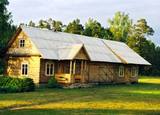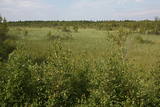| Nr | Nosaukums | Apraksts |
|---|---|---|
|
This cycling route will take you from Riga along the West coast of the Baltic Sea of Latvia and Lithuania. On the way the route passes the sea resort Jurmala with 19th century wooden archicture, the picturesque Abava river valley, geologicaly interesting steep banks of Jūrkalne, historically exiting city of Liepaja with great ambience and charming Kuldiga with the widest waterfall in Europe. In Lithuania the route goes through Palanga where Amber Museum is located and culminates at the National Park of the Curonian Spit with 60m high sand dune. |
||
|
1996. g. atklātais piemineklis (tēlniece: A. Veinbaha) Dagdā (starp Asūnes un Rēzeknes ielām) ir piemiņas vieta komunisma terora upuriem. No šejienes paveras labs skats uz salām bagāto Dagdas ezeru. |
||
|
The Great Ķemeri Bog Boardwalk is located in Ķemeri National Park. The national park covers an area of 38,165 hectares. The Great Ķemeri Bog Boardwalk immerses visitors in the world of moss, small pine trees, deep pools, tiny dark lakes and the smell of wild rosemary. An astute visitor will notice the carnivorous sundew plant and a variety of birds – wood sandpipers, white wagtails and tree pipits – and will also be able to hear cranes further away. Those who prefer shorter strolls can take the small boardwalk loop (approx. 1.4 km), while those who choose the great loop (approx. 3.4 km) will be rewarded with the opportunity to climb to a viewing platform that offers a magnificent view of the bog from above. The Great Ķemeri Bog Boardwalk has become a popular place for landscape and wildlife photographers. The whole trail is laid to wooden boardwalk and therefore is fully accessible and can be walked without a professional guide. |
||
|
Kafejnīca „Sprīdīši” atrodas rakstnieces Annas Brigaderes muzeja pagrabiņā, Tērvetes upītes krastā. Vasarās ēdienu var izbaudīt uz ārā terases. Piedāvā ballītes kopā ar Tērvetes meža labajām raganiņām un vizināšanos zirga pajūgā (vasarās) vai kamanās (sniegotās ziemās). Latviešu virtuve: Cūkgaļas ribiņas medus mērcē, pankūkas ar ievārījumu, sēņu mērce. Īpašais ēdiens: „Lāča ķepa”. |
||
|
Saimniecības darbības veidi: liellopu un jaunlopu, garšaugu, mētru un bērzu stādu audzēšana un realizācija. Tūrisma pakalpojumi - apskatāmas skulptūras no sūnām un citiem materiāliem, saimniecības un dzimtas vēsture, seni darbarīki, ārstniecības augu, garšaugu un dažādu veidu mētru kolekcija, putni un poniji. |
||
|
Kuģītis "Baltā Kaza" vizina tūristus pa Daugavu un darbojas arī kā pārceltuve no Jaunjelgavas uz Skrīveriem. Vasaras sezonā kursē regulāros laikos. Iespējamas arī ekskursijas un izbraucieni līdz Mīlestības saliņai, Aizkraukles pilsdrupām, Ķeguma HES u.c. Iespējami arī citi maršruti. 25 pasažieru vietas. Braucienu laikā var iepazīties ar Daugavas abu krastu kultūrvēsturisko, vēsturisko, bioloģisko objektu stāstījumu. Ķuģīša īpašnieks rīko pasākumus, koncertus gan uz Daugavas, gan Daugavas krastā. Piestātnē iespēja iznomāt SUP dēļus, airu un kanoe laivas, katamarānus. |
||
|
Klinšu smilšakmens ieži veidojušies, ūdens straumēm sanesot smilšainas, mālainas iežu daļiņas. Tās lēnām nogulsnējās un sablīvējās, topot par vareniem dabas veidojumiem! Līgatnes pagrabu alas savām rokām radījuši senie iedzīvotāji. Šī neparastā vieta ļāvusi daudzām paaudzēm izdzīvot, jo alās bija iespēja uzglabāt nepieciešamās pārtikas rezerves. Alām ir nemainīga temperatūra, kas padara tās par drošu pārtikas produktu un dzērienu glabātuvi. |
||
|
Trušu audzēšanas saimniecība "Trušu muiža" savā allaž tapšanas procesā esošajā garaušu muižas kompleksā piedāvā aplūkot 15 – 20 dažādu šķirņu trušus no visas pasaules, kā arī iegūt bildi ar trusi. Lieliska iespēja ciemoties trušu "Harmonijas un miera sētā", tos samīļot, pabarot. "Trušu muiža" iegūst aizvien jaunus kaimiņus un pilnveidojas. Iespēja iegādāties "Trušu muižas" greznumlietas. Vaislas truši un mīļdzīvnieki. Vasaras sezonā (jūnijs - augusts) gaidīs ciemos no otrdienas līdz svētdienai (11:00 – 18:00). Lielākas grupas, iepriekš vienojoties, uzņem arī citā laikā. |
||
|
Piedāvā ļoti gardus Lietuviešu tradicionālos ēdienus. Var pieņemt līdz 80 personām. Pieņem bankas kartes, pieejama autostāvvieta. |
||
|
Maršruts veidots pa ainaviskākajām Igaunijas dabas teritorijām – Monzunda biosfēras rezervātu, Matsalu nacionālo parku un Viidumäe rezervātu. Tas ietver divas dabas un kultūras pieminekļiem bagātākās un lielākās Igaunijas salas – Saaremaa un Hiiumaa, kā arī mazās Muhu un Kasari salas. Maršrutā iekļautas interesantākās dabas takas (garums 1 – 5 km), skatu torņi un putnu vērošanas vietas, ainavas un biotopi, kā arī trīs braucieni ar prāmjiem starp Monzunda arhipelāga salām. |
||
|
Otra Latvijas vecākā (1849. – 1850. g.), visaugstāk (82 m v.j.l., t.sk. 32 m augsts tornis) esošā un iekšzemē vistālāk (5 km no jūras) celtā bāka. Tās bākuguni izslēdza 1999. g. un mūsdienās bāka kalpo kā lielisks skatu tornis un izstāžu zāle. Skaidrā laikā no bākas labi redzams Irbes šaurums un Serves rags (Sāmsalā) ar Serves bāku. Pie bākas atrodas Šlīteres dabas taka, ko var iziet tikai nacionālā parka gida pavadībā. Taka atrodas dabas rezervātā, kur 1923. g. dibināja Šlīteres dabas pieminekli. Apmeklētāji varēs iepazīt Šlīteres Zilos kalnus - Baltijas ledus ezera senkrasta stāvo krauju, nogāžu un platlapju mežus, avoksnāju, kaļķainu zāļu purvu, kā arī senas meliorācijas grāvju atliekas un satrupējušos egļu stumbrus, kurus sagāza vējš 1969. gada orkāna laikā. Takas garums 1,2 km. Dabas izglītības centrs “Slītere” ietver dabas taku, bāku, ēku ar ekspozīciju “Dzīvība kokā”, kā arī pagalmu, kur notiek dabas izglītības nodarbības. |
||
|
Bārs "Stender's" atrodas Kuldīgas pilsētas centrā, galvenās Kuldīgas gājēju un riteņbraucēju ielas - Liepājas ielas - sākumā, un ir izvietojies ēkā, kuras vēsture iestiepjas vairākos iepriekšējos gadu simtos, kad tā kalpoja kā graudu klēts. Bārs atrodas ēkas otrajā stāvā, ar zemākajām durvju stenderēm Kudlīgā un koka bukiem bārā. Latviešu virtuve: Zemnieku brokastis, auzu pārslu putra, aukstā kefīra zupa, skābeņu, gurķu un pupiņu zupa, liellopa gaļa sīpolu mērcē, mednieku desiņas, kartupeļu pankūkas, saldās pankūkas ar brūkleņu mērci. |
||
|
Dinaburgas taka sākotnēji metas lejā un tad pēc strauja kāpuma uzved stāvajā Daugavas krastā, kur gravu ieskauts paceļas ap 25 m augstais Naujenes (Vecpils) pilskalns - Daugavpils pilsētas " šūpulis". Saglabājušās pilsdrupas, pie kurām izveidots unikāls Dinaburgas pils brīvdabas makets. Objekts atrodas Augšzemes aizsargājamo ainavu apvidū un Daugavas loku dabas parkā.
|
||
|
Redzamas pa lielu gabalu Vecumnieku – Skaistkalnes un Stelpes ceļu krustojuma tuvumā. Šīs Holdandes tipa vējdzirnavas uzcēla 1903. gadā. Sākot ar 20. gs. 30. gadiem dzirnavas darbojas ar elektrības palīdzību. Līdz mūsdienām ir saglabājušies vējdzirnavu vēsturiskie mehānismi. Kādreiz daudzie vējdzirnavu stāvi bija raksturīga Zemgales vēsturiskajam novadam, ko pamatoti dēvē par Latvijas „maizes klēti”. Diemžēl līdz mūsdienām ir saglabājušies tikai daži. Šīs vējdzirnavas ir apskatāmas tikai no ceļa malas.Ap 8 km rietumos (Iecavas virziens) redzamas vēl vienas – Kāravu vējdzirnavas. |
||
|
Lauku sētas atrodas pie upītes, ciema nomalē, kas jau izsenis bijusi mājvieta biškopjiem. Vieta piemērota mierīgai atpūtai. Izglītojošas nodarbības ikvienam, kas ir ieinteresēts Dzūkijas kulinārajā mantojuma, amatniecībā un tradīcijās. Maizes cepšana, pīrāgi ar sēnēm, olu rotāšana ar vasku, pinumi no salmiem. Vakarēšana ar dzuku dziesmām un dejām. Tautastērpu izgatavošana gan bērniem, gan pieaugušajiem. |
||
|
Atrodas Otepē augstienes R daļā. Viens no izciliem piemēriem, kā aizsargājamas dabas teritorijas vērtības un reljefs tiek izmantots rekreācijas, sporta un aktīvās atpūtas vajadzībām, jo parkā ir izveidota šim mērķim atbilstoša un kvalitatīva infrastruktūra.
|
||
|
Šeit uzstādīts piemiņas akmens K. Valdemāram, kas vēsta par viņa nopelniem Latvijas valsts attīstībā un veidošanā. Šajā vietā kādreiz atradās Rojas, jeb Lubezeres jūrskola, kurai blakus atradās skolotāju māja, kas saglabājusies līdz mūsdienām. Pašreiz te ierīkota Rojas ģimeņu ārstu privātprakses. Jūrskola pastāvēja laikā no 1873 – 1915. gadam, bet 1. pasaules kara laikā to sagrāva. Jūrskolā sagatavoja tuvbraucējus stūrmaņus. Šeit varēja mācīties bez maksas un mācību vielu apgūt latviešu valodā. Latviešu jūrnieki bija pazīstami Krievijā un ārzemēs, pat Amerikas kontinentā. Viņi tika cienīti lietpratības, krietnuma un uzticības dēļ. (Avots: Rojas TIC) |
||
|
Lai apskatītu purvu, tajā nav jābrien iekšā. Platenes purvu lieliski var pārlūkot no Ventspils Rīgas ceļa (starp 77. km stabiņu un autobusa pieturu „Pagrieziens uz Elkšķeni”), kur paveras tāls un plašs skats. Dabas lieguma nozīmīgākā aizsargājamā vērtība – kaļķains zāļu purvs ar rūsgano melnceri, kas ir šī biotopa lielāka atradne Latvijā. Uzmanīgi un valsts nozīmes autoceļa – apstājieties tikai atļautā vietā, netraucējot satiksmi! Dažus kilometrus Rīgas virzienā autoceļa malā uz Grīžu Velna krēslu, kas ir interesants dižakmens (aizsargājams).
|
||
|
Vecpiebalgas pagasta „Lejas Kaikašos”, rakstnieka Antona Austriņa (1884–1934) dzimtajās mājās, kopš 1990. gada durvis ver piemiņas muzejs. Šeit var iedziļināties viņa dzīvē un literārajā mantojumā, kā arī sajust laikmeta garu, kas veidojis viņa personību. „Mūsmāja nav tikai pajumte, patvērums pret lietu un vēju, viņā uzglabājies arī kāds |
||
|
Liellopu izsoļu nams ir vienīgais liellopu izsoļu nams Baltijā. Izsoles tiek rīkotas gaļas šķirņu jaunlopiem - buļļiem un telēm vecumā līdz 12 mēnešiem, regulāri - divas reizes mēnesī. Katru mēnesi izsolēs piedalās vairāk kā 2000 Latvijā audzēti jaunlopi. |
||






















